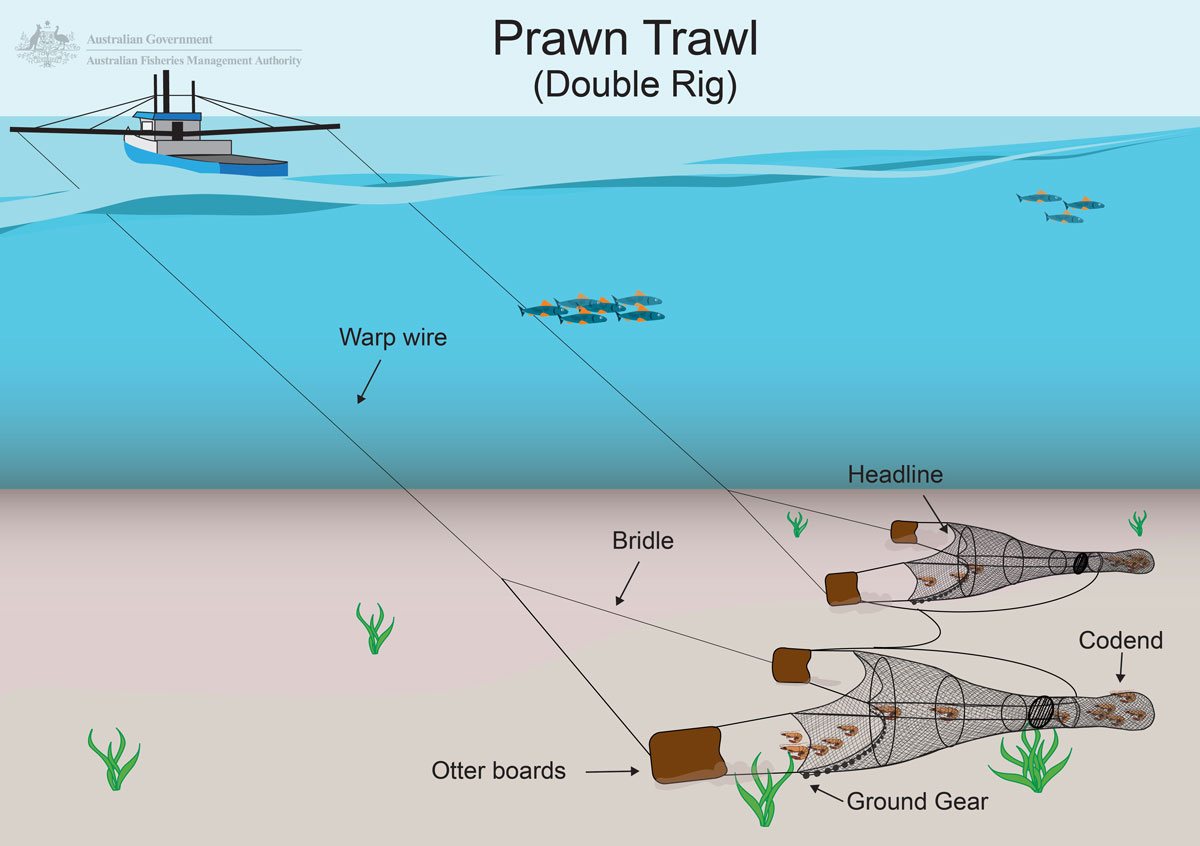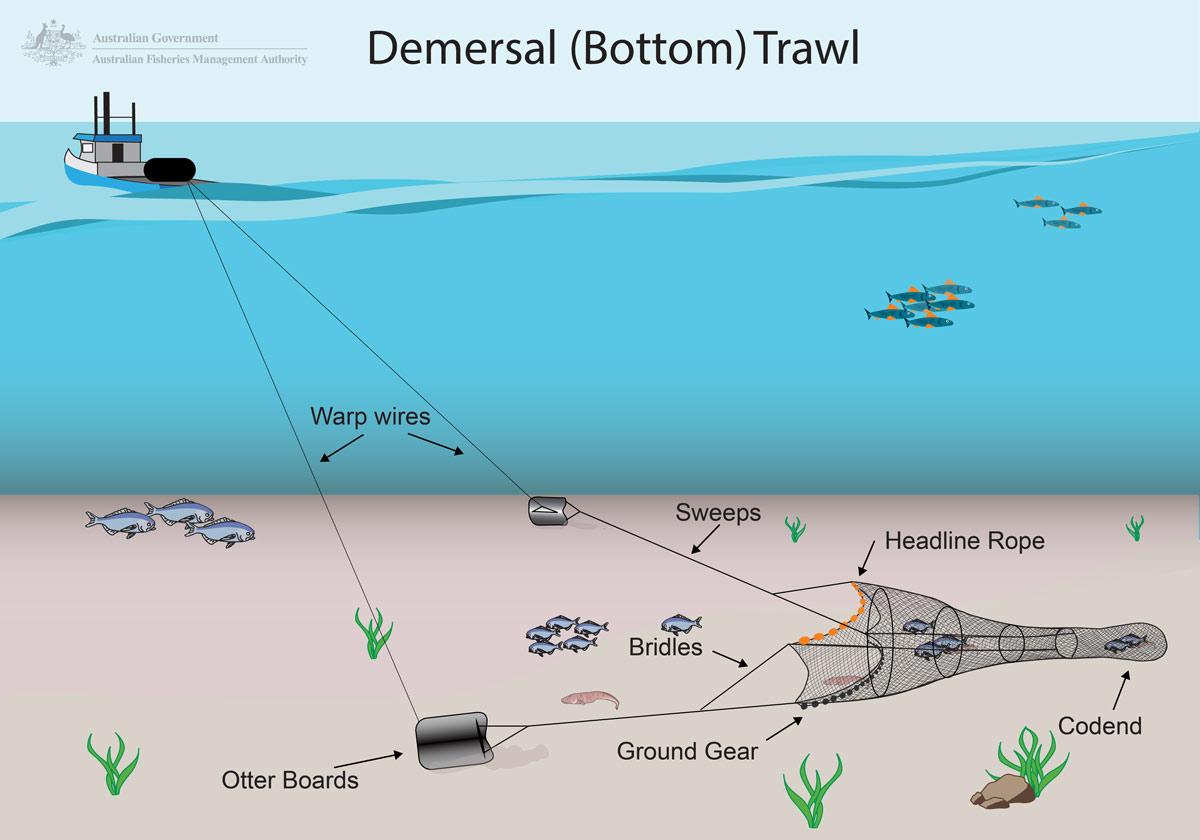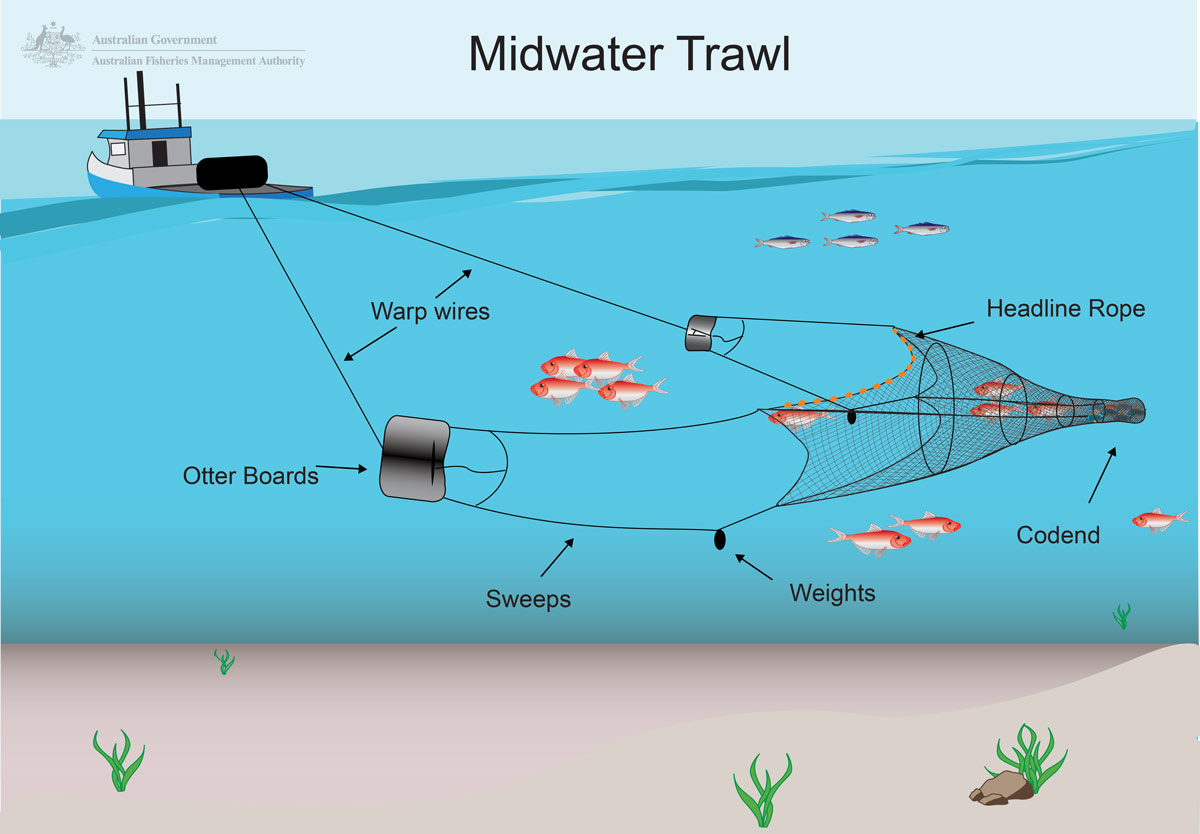Trawling is one of the most common methods of fishing. Trawl nets are designed to be towed by a boat through the water column (midwater trawl) or along the sea floor (bottom trawl).
Trawl nets are shaped like a cone or funnel with a wide opening to catch fish or crustaceans and a narrow, closed ‘cod-end’. Trawls can be used at various depths and nets differ by their mesh size.
Both bottom and midwater trawls use otterboards/trawl doors to keep the mouth of the net open.


Bottom trawls (also known as demersal trawl) are used to catch fish and prawns that live on or near the sea floor.
Species targeted
The main species targeted by bottom trawl are:
How bottom trawls work
Bottom trawls use trawl boards/doors made of timber or steel, to keep the mouth of the net open and on the bottom.
Trawl nets are designed differently depending on whether the target species is fish or prawns.
Fish trawls
Fish trawls are towed as a single net over the back end of a boat. Some trawl boats have a ramp at the back of the boat to set and retrieve the net and others retrieve from the side.
Fish trawls have long metal cables, called sweeps, connecting the trawl boards with the net which allow the boards to spread much further than the overall width of the net. The sweeps ‘herd’ fish until they tire and drop back into the net where they are finally caught. Trawl nets have bobbins or rollers on the ground gear to allow the net to move over the sea floor without snagging and to minimize bottom contact.
The sizes of trawl nets vary, however there are minimum mesh size restrictions in place for certain fisheries.
Prawns trawls
Prawn trawls can be towed in multiples of two, three or four nets, with long arms (or booms) extending out from each side of the boat to allow the nets to fully open.
Prawn trawl nets use ground chain for weight so it skims the seabed and encourages prawns living on the sea floor up into the trawl mouth. Prawn trawl nets don’t have long sweeps and the nets have smaller mesh than fish trawls.
Environmental impacts and management
Sometimes, bottom trawling can catch unwanted species of fish or other sea creatures. This is known as bycatch and it is monitored by on-board fishery observers.
Although it is not physically possible to trawl on reef structures, significant damage can occur if sensitive habitat areas like corals, sponges and seagrass beds are trawled. To ensure these sensitive habitat areas are protected from trawling, management arrangements such as area closures are extensively used.
Physical devices, such as excluder and bycatch reduction devices within trawl nets, are used by fishers to divert unwanted species out of the net. This is important as it allows small fish, larger animals and protected species to escape the net.
AFMA’s management of commercial trawl fisheries aims to ensure trawl fishing has the least impact possible on the environment.

Midwater trawls fish in the water column and are used to catch a variety of pelagic fish species. Midwater trawl nets may incorporate acoustic technology to tell the skipper the position of the net in the water column, the opening/spread of the net and the volume of fish entering the net.
Species targeted
In the Small Pelagic Fishery, midwater trawl is used to catch small pelagic species such as jack mackerel, blue mackerel, redbait and Australian sardine.
In the Commonwealth Trawl Sector of the Southern and Eastern Scalefish and Shark Fishery, midwater trawl is mainly used to target blue grenadier off the west coast of Tasmania between June and August. It can also be used to target alfonsino.
How midwater trawl works
Midwater trawling involves towing a net behind a boat to catch fish species. The net is connected to the boat by the warp wires and the opening to the net is spread using two large boards known as otter boards. The net is towed off the bottom in depths from just off the bottom to near the surface. Midwater trawl nets are usually shaped like a cone or a funnel with a wide opening to catch fish and a narrow end called a codend where fish are collected.
The sizes of midwater trawl nets vary, however there are minimum mesh size restrictions in place for certain fisheries.
Environmental impacts and management
Midwater trawl gear has minimal impact on the environment primarily because it doesn’t come into contact with the seabed. Seals were identified as one of the species at risk from midwater trawling in the freezer boat sector, however AFMA requires these boats to use seal exclusion devices or ‘SEDs’ to protect species such as seals. In 2013 a ‘hydrostatic release’ to keep nets closed until they are too deep to be reached by seals looking for food was tested. This was effective in further reducing the risk of seal deaths.